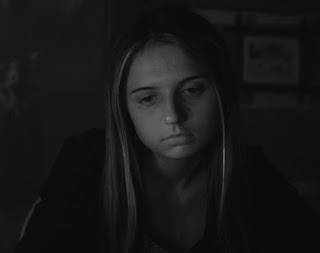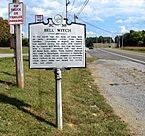Text © Richard
Gary / Indie Horror Films, 2020
Images from
the Internet
The Mark of the Bell Witch
Directed by Seth
Breedlove
Small Town
Monsters
85 minutes, 2020
www.smalltownmonsterss.com
Seth Breedlove has become a cinematic cryptid monster maven over the years, directing a number of documentaries about mysterious creatures that may or may not exist, such as Bigfoot, the Mothman and the Missouri Monster (aka Momo). A few of his releases have been reviewed on this blog; if you search for his name, you will find them.
For his latest, Breedlove dissects the Bell Witch haunting in the Appalachian Mountains of Tennessee, arguably one of the more infamous and deadly hauntings in American history. I remember learning about it as a youth from a Ripley’s Believe It or Not comic book, and it has been adapted into movies, books, and other comics over the years.
As with most adaptations, these other sources tended to be glorified versions to enhance the “scare” factor, which led to parts of the story being left out due to time. Breedlove aims to be more comprehensive. He not only has interviews with residents of the area of Adams, Tennessee (population 600), but also has the events play out with actors in black and white “flashbacks.”
Of course, there are no first-hand witnesses interviewed because, well, the events depicted are from nearly 200 years ago, in 1817 to 1821, on a farm run by John Bell, Sr. and his family. This is, however, due to its urban legend status, one of the more documented “hauntings” in American history, especially in that neck of the woods, yawl. It was first written about in M.V. Ingram’s book regarding the Bell Witch from 1894, An Authenticated History of the Famous Bell Witch.
The manifestation started slowly with knocks and raps on the walls and doors, then with strange animals like a mysterious hare (not a common rodent in that environment; as King Arthur might say, “Jesus Christ, that rabbit is dynamite!”) or a trash-talking Cerberus-type pooch with two heads (and this is way before Triumph, the insult dog).
If you are into this kind of thing, you probably know that poltergeists are attracted to young people, especially women, and this fits here as one of the victims of malevolence (hair pulling, welts, etc.) was Betsy (played by Sue Matzke), the youngest of the Bell children who was in her late pre-teens, just the right age for the spooky pokings. Perhaps it was a possession of poor Betsy? Tyler Estep, a pastor who in interviewed, says the area was ripe with Protestant revivalism at the time, which may have led to “spiritual warfare.” As a skeptic, I’m – err – skeptical.
As the power of the Witch (apparently named Kate) grew and developed a literal voice, preachers were called left and right to try and figure out what was going on, supposedly talking to the spirit. I like how Breedlove gives multiple explanations of possibilities, whether it was the curse of a neighbor on the clan, or the spirit of a disturbed Native American’s resting place, or perhaps a demon, leaving it open rather than positing an answer that would be a guess at best.
Although no mention of their works are listed, there are multiple interviews with authors, such as Timothy Henson (also the historian for Adams), John Baker Jr., and Pat Fitzhugh (The Bell Witch: The Full Account, 2000; I looked this up myself), so the connection to the legend is unclear. There are also folklorists and historians like Brandon Barker and Beau Adams, a Classics professor named Heather Moser, and the host of “Astonishing Legends,” Forrest Burgess. Again, in many cases, the link to the story is not transparent, which is arguably the weakest point of the documentary, even if their stories are interesting and occasionally far-fetched (especially the Christian and “spirituality” end of it).
The thing about any media dealing with a Cryptid topic is one can say anything, since there is little real info. Was Bigfoot circumcised? Does Mothman dislike light? Sure, why not; try proving it’s either true or not. But on the flip side of that coin, that’s also part of the appeal: it’s the mystery of the whole thing. That’s why I find it so fascinating and enjoy Breedlove’s work, including this one.
Having the story play out in black and white scenarios really boosts the tale, keeping it from getting too bogged down in talking heads by just relating the events. Smart move. Either way, John Bell Sr., died of poisoning, supposedly given to him by the Witch. Of course, I have my own thoughts, such as their slaves concocting a way to get rid of a bad master, or possibly Betsy was abused by her dear old dad and her welts were by him – even if she was somewhat in denial – with her getting him outta da way.
That does not, however, fit with other parts of the legend, such as the apparition appearing to neighbors in their own abodes, or that one entity would migrate into multiple ones (perhaps a family), so who knows. The point is, the facts were written down by one of the Bell’s sons to start, which we hear parts through the narration of actor Lauren Ashley Carter (star of the 2013 cult classic Jug Face) and then the just grew exponentially after that, much of it written years if not decades after the “fact.” A majority of what was published was when pulp fiction was becoming popular, with the likes of the Western Tall Tales (Davy Crockett’s feats, Paul Bunyan, and Mickey Finn, to name a few) and legends of crime like Billy the Kid being fed to an audience fascinated by a new medium.
Again, it all comes down to what is real and what is
not, and with cases like this, there is the speculation of the gray areas in
between with possibilities and tales to be told around a campfire. Breedlove
does well to collect this information, present it in an easy and palpable form,
and lets the audience speculate on what might have been a rare supernatural
murder.




No comments:
Post a Comment